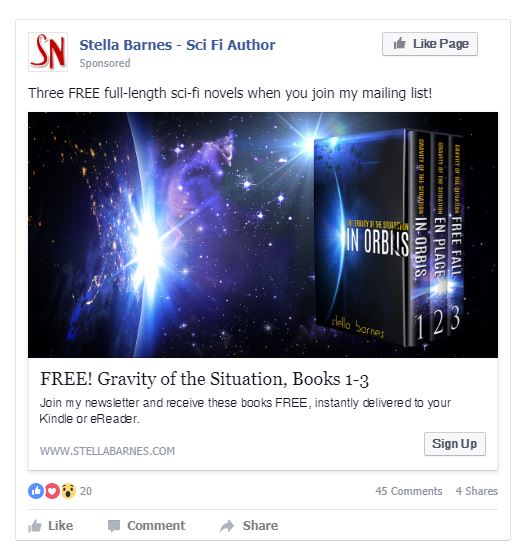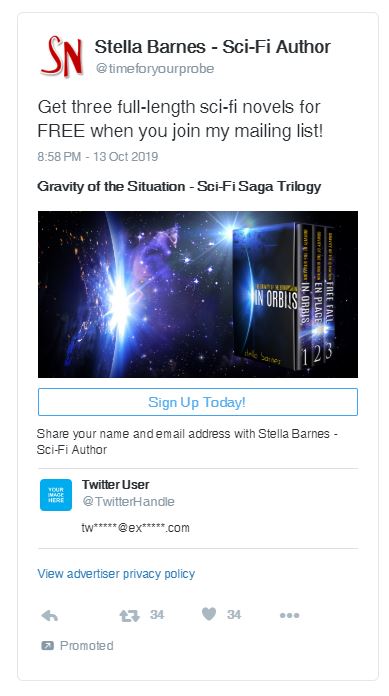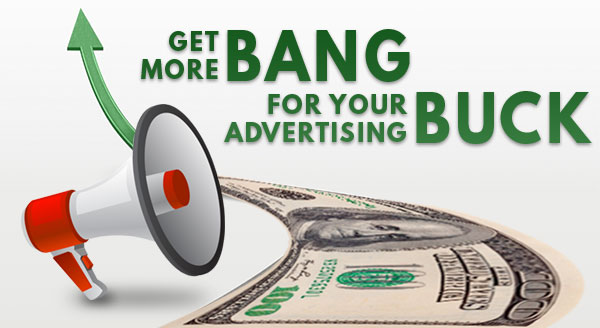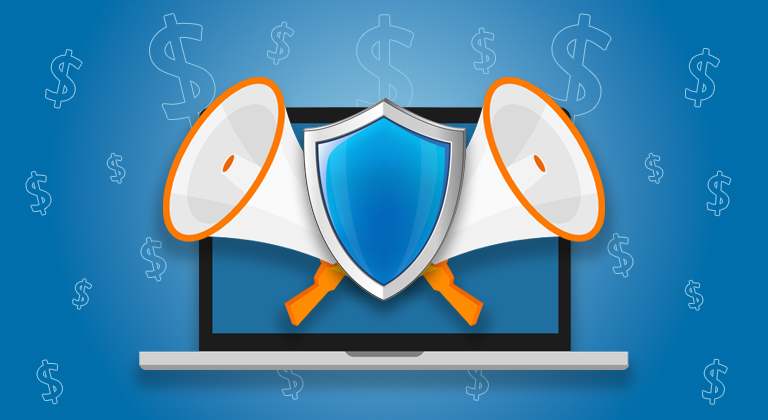Stretching Your Ad Budget (Part 2) – Gaining Subscribers
In part one of this series, we discussed using your ad budget to sell more books, but there are other goals that successful authors use advertising for, such as growing the core group of fans that they can reach regularly via their mailing list. Instead of spending your ad dollars on selling a book once to a random person, you can instead spend those same dollars to have that person join your list so that you can sell to them over and over again in the future – without any additional costs. That makes gaining subscribers one of the most effective investments you can make.
In part one, we discussed the challenge of getting the most value from your advertising budget – and how important the concept of strategy was. Tactics are the specific things you do to achieve your goals – which platforms you use, for example – whereas your strategy is the more overriding goal of your advertising.
The most instinctive strategy is using advertising to sell books, and there are a variety of tactics you can use in that endeavor; from advertising directly on Facebook or the Advertising on Amazon platform, to using third-party websites or newsletters to promote your books.
One of the disadvantages of using advertising to sell books is that it’s a challenge to rein in your costs. I’ve discussed before the challenge of getting a return on investment when you advertise books – since if a book retails for $2.99 and you receive $2.00 in royalties, you can’t spend more than that per sale, otherwise your advertising is costing you more than you make in sales. Given that cost-per-clicks on AMS frequently fall into the $0.50 range or higher, you’ve got to get a sale for every three or four customers you drive to your book page.
Don’t get me wrong – authors do it. In fact, authors can trim down their cost-per-clicks and drive up their conversation ratios until their advertising is a money-generating machine; and their ranks and sales demonstrate that. However, it’s not easy – if it was, everybody would be doing it. Secondly, it doesn’t work for every book – romance books are much easier to sell than literary fiction, for example.
If your budget is limited and you want the maximum impact for it, there is another option.
Strategy #2 – Gain More Subscribers
One of the cornerstones of any successful self-publishing career is a mailing list.
This is a collection of email addresses that you can reach out to again and again, through a service like Mailchimp. Every time you have a new book release, or need to gain more reviews, or want some impact for your social media posts, you can send out an email to your subscribers and you have a much higher chance of them actually taking action. In fact, there’s a prevailing theory that 10,000 subscribers is what you need to make your publishing career ‘self-sustaining’ – although how accurate that is, I couldn’t tell you.
I will say this, though – my subscribers have helped me ensure a hard-hitting launch on release day and are what enabled me to turn writing into a career, and it should certainly be one of your core strategies as an author if you intend to do the same.
How do you get subscribers?
The first thing you’ll need to do in order to effectively manage a list of subscribers is sign up for a service like Mailchimp, or another email distribution service. These enable you to send beautifully-formatted emails to thousands of subscribers, which you simply can’t do using regular email. It also helps you track open rates, unsubscribes and other details which can be invaluable as you build your career as an author and your relationship with these readers.
Whichever service you use, you’ll generally generate a URL which will take people to a landing page where they can subscribe to your mailing list. The first and most fundamental thing to do is include this link in your back-matter in your books – so people who enjoyed reading your work can tap their screen and automatically subscribe.
However, there’s a bit of a chicken-and-the-egg problem here. The more subscribers you have, the more impact your books can have when they launch. However, your books need to have impact when they launch for you to successfully gain new subscribers in any meaningful number.
This is why advertising for them is a useful way to accelerate that process.
Tactic #1 – Your Reader Magnet
Once upon a time, people used to plug their email addresses into anything. Now – after being bombarded with sales messages – they’re a little pickier.
For that reason, the first and most powerful tool you have to build your subscriber list is a Reader Magnet.
A Reader Magnet is something of yours which readers can get hold of for free (in reality, in exchange for their email address) and get looped into your mailing list. A lot of authors write a short novella as their reader magnet, or give away a free chapter…
…I’m not going to lie: I give them three full books. Yep – I provide the first three books in my 10-book series; because I intend to keep writing, and three books is a powerful way to hook readers into my entire series.
You can host your ‘free’ book on a service like BookFunnel or Prolific and you’ll receive a link which will direct people to a page where they can have the book delivered directly to their Kindle or eReader. It’s super seamless, and that’s valuable because you want to get your subscribers reading as quickly and easily as possible. That URL can also be hooked into Facebook, Mailchimp or other advertising platforms so once subscribers give you their email address, it’ll direct them straight to the free book you promised.
Creating a reader magnet has the cost of publishing and assembling a book – so it’s definitely an investment you’d like to see a return on – but it’s such a powerful way to attract subscribers that I wouldn’t recommend any of the other tactics without having created a reader magnet and hosted it somewhere.
- PROS: You have a powerful book to hook readers into your series immediately. It’s really non-negotiable.
- CONS: You’ll have to write it and publish it, and might never see a direct financial reward except in the way of subscribers.
Tactic #2 – Advertising on Facebook
If you want subscribers, Facebook’s advertising platform is an incredibly powerful way to reach people. That’s why I suggested selling books on it last week! In this case, though, because you’re using it to chase subscribers rather than book sales, every lead you get stays with you. If you pay $1 for a subscriber, but they buy three books off you at $0.99 each during their time on your list, you’ll have made your money back. Anything after that is pure profit.
Another benefit is that Facebook can do all the administration work for you. They have an advertising template called “lead generation” that can collect information from interested subscribers and then add it seamlessly to your Mailchimp or other mailing list dashboard. It can even direct the signers-up to a new page afterward, so if you offer an incentive for them to join your mailing list – like a free book – than it makes the entire system automated.
For the past five years, I’ve spent about $5 a day on building my mailing lists through Facebook, and it’s totally changed the game for me – and it’s one of the cornerstones of many other successful authors as well. The keys to success involve having an incentive to give away – for example, I offer a bundle of the first three books in my series – and then optimizing your ad with a ‘lookalike audience’ once you’ve gained enough subscribers to build one.
- PROS: Facebook is one of the most direct and powerful advertising platforms going, and their Lead Generation campaign is a powerful and effective method of building your mailing list.
- CONS: Gaining subscribers is becoming increasingly more expensive as more and more authors start to use it.

Tactic #3 – Advertising on Other Social Media
When it comes to gaining subscribers, Facebook is very far from the only game in town – and users have reported significant success with Twitter, Instagram and even YouTube. In fact, there’s something of an advantage to advertising on other channels because they’re not inundated in quite the same way that Facebook users currently are.
Each social platform has different advantages, and some offer lead generation ads just like Facebook – in fact, Instagram is even plugged into Facebook. Even if you don’t fancy using their strict lead generation tools, the advantage of services like Mailchimp is that you can provide a single URL that will automatically take readers to a landing page where they can sign up.
Another advantage of using different advertising platforms is that their rules regarding the content of the ads can vary – so, for example, Facebook’s rule of “no more that 20% wording” on an ad isn’t applicable on other platforms.
- PROS: There are significant cost advantages to advertising on other platforms, and they’re less saturated at the moment.
- CONS: You’ll have to learn the ins and outs of each platform individually, and might lose money before you get the hang of it.

Tactic #4 – Newsletter Swaps
One of the best ways of stretching your advertising dollars is not to spend them at all! But that’s not to say other approaches to gaining subscribers don’t come without cost. One tactic employed by a lot of authors to grow their subscriber base is to team up with other authors from similar genres and work together on campaigns like a ‘newsletter swap.’
What does that mean? Well, it depends – but the idea is for authors to reach out to their own mailing lists and promote the work of other authors – assuming that if some of their own subscribers sign up to that author’s newsletter, it might also mean their subscribers sign up to yours.
It’s a tactic that saw a lot of favor for a while, but the danger of being regularly involved in newsletter swaps like this is that you’re diluting your subscriber base. While you might gain new subscribers to your own list, remember that they’re still subscribed to the previous author’s newsletters as well. Now, they’ll receive double the traffic.
Now, there’s nothing wrong with promoting another author’s work through your mailing list – it’s a tit-for-tat tactic which I’ve used many times with success. If the author you’re promoting isn’t in the same genre as you – or you’re months away from a new book release in any case – it’s really not much of a problem to promote a single book to your subscribers.
But when you get involved in larger newsletter swaps – the largest I’ve ever been a part of was six – you’ll start to significantly dilute your subscribers. Remember, this is different to simply promoting another author’s book one time – you’re giving your subscribers to this collective list. This means every subscriber of yours who signs up will now have six more newsletters filling up their inbox, six more regular book releases to be potential ARCs for, and six new launch funnels to spend their hard earned dollars on. It’s no surprise their value as subscribers to you starts to soften.
I mentioned above that this tactic is deceptive because it appears to be ‘free’ – but in reality, you’re ‘paying’ for it in the effectiveness of your subscriber base. If you’ve actually paid money to build this list, you should make the mental connection that you are indeed ‘paying’ for what you get; and it’s up to you whether what you receive is worth the sacrifice.
- PROS: You’re leveraging an asset you’ve already paid for – your subscribers – so there’s no direct upfront cost.
- CONS: You might be cannibalizing the effectiveness of your own mailing list, and the subscribers you gain as a result might already be bombarded with author messages.
Subscribers are a not a ‘nice to have’ – they’re a ‘HAVE to have’
One of the misleading things about describing author strategies in this way is that it comes across as if you can pick and choose between them. To a certain extent, that’s true – but just like with everything in life, the real power comes from a holistic combination of strategies.
I mean, look at swimming – kicking your legs and moving your arms are independent strategies, but you’ll need to employ both in order to avoid drowning!
Self-publishing has existed for long enough now that there’s a road map towards breaking out as a successful author. The two hardest parts are the ones that prevent everybody becoming an author – actually writing a damn book in the first place, and then writing and publishing something people want to read. Once you’ve got that, though, the road to success follows a similar path for most authors; and advertising and marketing have now become an essential part of it.
While advertising is important, building a subscriber list is generally accepted as the key to being a successful author.
The larger your list and the more engagement you have with your readers, the bigger each of your new book launches is; and the faster your career snowballs. A strong mailing list eventually eliminates the need for some third-party services, and it ensures your books all launch with strong first-day rankings. It’s still the most powerful way to connect with your readers, so when we discuss ‘return on investment’ it’s a bit of a misnomer with subscribers.
Sure, you want to spend your money effectively – but you have to spend it on gaining subscribers, even if you feel you’re spending too much. Each subscriber you gain will get you closer to your eventual goal of being a financially independent author, so it’s worth spending more in the short term because you’ll get it back in the long term.
The key is to work out which methods are most effective for you – and keep honing them down. When I started advertising on Facebook for subscribers, for example, I spent nearly $2 per lead for the first 100 subscribers. Then, however, I was able to input that information into Facebook and generate a ‘lookalike’ audience which shredded my cost-per-lead to less than half a dollar.
I started this series by focusing on selling books, because that’s the natural goal authors will gravitate towards when considering advertising. However, in the long term, I think that gaining a subscriber base is even more important; and if you truly want ‘bang for your buck’ then this is where you should start.
In the final part of this series, we’ll tackle what might seem like a contradiction – how to get a good return on investment by giving your book away for free! Stay tuned!












Good post but may I suggest there is a follow-up detailing the exact mechanics of generating email addresses using Facebook.
That’s a new one on me. Thanks!
Great article! Good to see mention of the “chicken and egg” problem. Lots of those in self-publishing. And thanks for sharing the nuts and bolts of your experience, including costs. Five bucks a day on Facebook seems like a lot, but if it gets you ten subscribers… And of course you have to keep publishing regularly. It’s a lot to work up to!